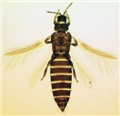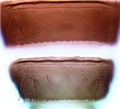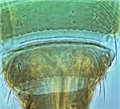Thrips madronii
Recognition data
Distinguishing features
Both sexes fully winged. Body brown, tarsi yellowish, also apex of mid and hind tibiae; major setae brown; antennae brown, segment III paler; forewings brown, base pale. Head wider than long; two pairs of ocellar setae; pair III arising on anterior margins of ocellar triangle; postocular setae pair I almost as long as ocellar setae III. Antennae 7-segmented; segments III � IV with short forked sensorium. Pronotum with many distinct transverse lines; two pairs of long posteroangular setae; posterior margin with three pairs of setae. Metanotum with irregularly elongate reticulation, transverse at anterior; median setae arising behind anterior margin; campaniform sensilla present. Forewing first vein with three (or two) setae on distal half; second vein with row of about 14 setae. Abdominal tergite II with three lateral marginal setae; sculpture on median tergites not extending to median pair of tergal setae; V � VIII with paired ctenidia laterally, on VIII posteromesad to spiracles; tergite VIII posteromarginal comb absent medially, with irregular slender microtrichia laterally; pleurotergites without discal setae, sculpture lines bearing dentate microtrichia. Sternite II with two pairs of marginal setae, III � VII with three pairs; sternites without discal setae. Male smaller; tergite VIII comb absent; sternites III � VI with transversely oval glandular area.
Related and similar species
The genus Thrips is the second largest genus in the Thysanoptera, and currently includes, worldwide, about 280 species. T. madronii appears to be a particularly common flower thrips in California. It has been compared by Nakahara (1994) both to a species found in the eastern States, T. varipes Hood, and to the widespread European T. major Uzel, but it differs from both of these in having dentate, not ciliate, microtrichia on the pleurotergites. It can also be confused with T. magnus , but that has the pronotum with weaker sculpture, and the males have glandular areas on sternites III � VII. All members of genus Thrips lack ocellar setae I on the head, and they all have ctenidia on tergite VIII posteromesad to the spiracles. Other characters, such as number of antennal segments, number of setae on the forewing veins, and number of discal setae on the sternites are variable between species (Palmer, 1992; Nakahara, 1994; Mound & Masumoto, 2005).
Taxonomic data
Current valid name
Thrips madronii Moulton
Original name and synonyms
Thrips madronii Moulton, 1907: 57
Thrips sambucifloris Hood, 1934: 177
Family placement
Thripidae, Thripinae
Biological data
Life history
Presumably breeding in flowers.
Host plants
Adults have been taken from plants in a range of families with no recognized specificity.
Tospoviruses vectored
None
Crop damage
None
Distribution data
Area of origin
Western USA
Distribution
California, Oregon, Washington, British Columbia, Mexico.









